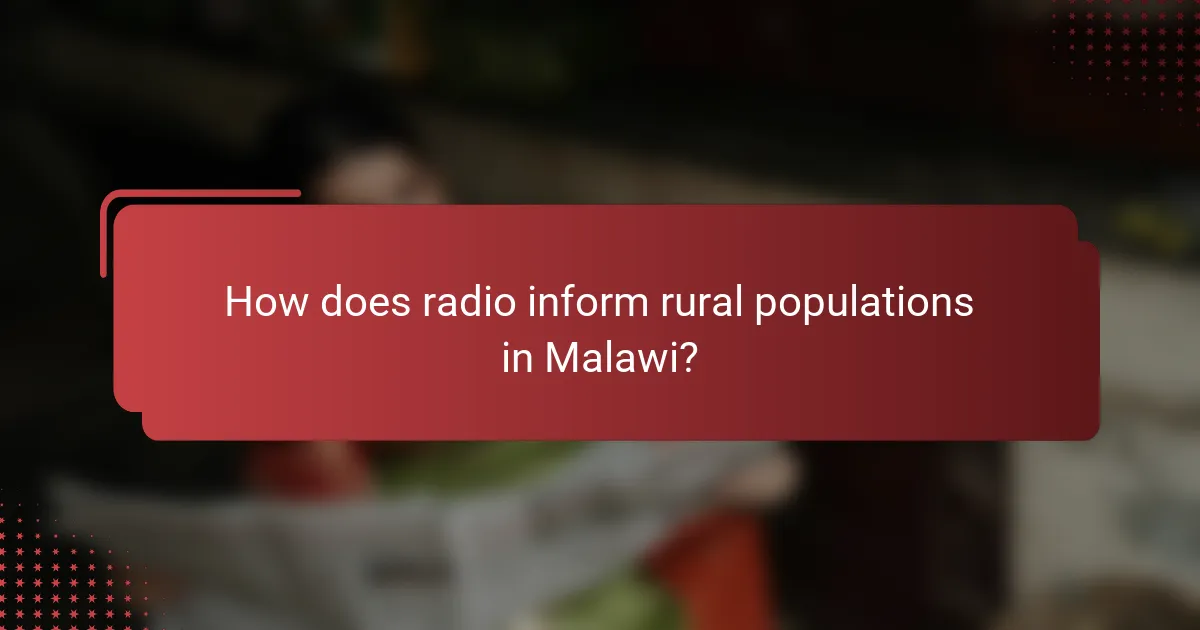The article examines local news trends in Malawi, emphasizing the significant role of radio as a primary information source for rural populations. It highlights the growing number of community radio stations that address local issues often overlooked by mainstream media, while also focusing on health and agricultural news relevant to rural communities. Recent reports indicate a surge in radio listenership, particularly during elections, underscoring its influence on public opinion. The article also discusses the future prospects of radio in Malawi, noting the impact of mobile technology and government support for media diversification, alongside challenges such as funding and competition from digital platforms.

What are the current local news trends in Malawi?
Current local news trends in Malawi focus on the influence of radio in rural areas. Radio remains a primary source of information for many Malawians. It plays a crucial role in disseminating news and educational content. Recent trends show an increase in community radio stations. These stations often cover local issues that mainstream media may overlook. They also engage listeners through interactive programming. Additionally, there is a growing emphasis on health and agricultural news. This content addresses the needs of rural populations. Reports indicate that radio listenership has surged, especially during elections. This highlights radio’s importance in shaping public opinion and awareness.
How is radio utilized as a medium for local news in Malawi?
Radio serves as a primary medium for local news in Malawi. It provides timely updates and information to rural populations. Many Malawians rely on radio due to limited access to the internet. Local radio stations broadcast news in local languages, enhancing comprehension. These stations cover various topics, including politics, health, and agriculture. Community engagement is promoted through call-in programs and discussions. Research shows that radio reaches over 70% of Malawian households. This accessibility makes it a crucial tool for informing and educating citizens.
What are the key characteristics of radio news broadcasts in rural areas?
Radio news broadcasts in rural areas are characterized by localized content, accessibility, and community engagement. Localized content focuses on issues relevant to the rural population, such as agriculture, health, and education. Accessibility is enhanced by the use of simple language and relatable storytelling. Community engagement is fostered through listener participation, allowing audiences to share their views and experiences. These broadcasts often prioritize timely information about local events and emergencies. Additionally, they may include traditional music and cultural segments to resonate with the audience. Research indicates that rural radio plays a crucial role in bridging the information gap in underserved areas.
How does radio compare to other forms of media in rural Malawi?
Radio is the most accessible and widely used form of media in rural Malawi. It reaches a larger audience compared to print media, which is limited by literacy rates. Many rural residents rely on radio for news and information due to the lack of electricity and internet access. According to the Malawi Communications Regulatory Authority, radio [censured] in rural areas is over 80%. In contrast, newspaper circulation is significantly lower, often less than 5% in these regions. Additionally, radio broadcasts are often in local languages, making them more relatable and easier to understand. This accessibility solidifies radio’s role as a primary source of information in rural Malawi.
Why is local news important for rural populations in Malawi?
Local news is crucial for rural populations in Malawi as it provides essential information about community issues. It helps residents stay informed about local events, agricultural updates, and health services. Access to localized content fosters community engagement and participation. Local news also serves as a platform for addressing local concerns and promoting dialogue. In Malawi, where literacy rates may be low, radio remains a primary source of news. According to a 2020 report by the Malawi Communications Regulatory Authority, over 80% of rural households rely on radio for information. This highlights the significance of local news in bridging the information gap in these communities.
What role does local news play in community engagement?
Local news plays a crucial role in community engagement by providing relevant information to residents. It fosters a sense of belonging and connection among community members. Local news outlets often cover events, issues, and stories that directly affect the community. This coverage encourages public participation in local governance and civic activities. Studies show that communities with strong local news have higher voter turnout and increased involvement in local issues. For instance, a report by the Pew Research Center highlights that local news increases awareness of community events and local government actions. Thus, local news serves as a vital link between residents and their community, enhancing overall engagement.
How does local news impact decision-making in rural communities?
Local news significantly influences decision-making in rural communities. It provides essential information on local events, policies, and issues. This information helps residents make informed choices about their lives. For example, local news can inform farmers about weather patterns and market prices. Research indicates that communities with access to local news have higher civic engagement. Studies show that radio plays a crucial role in disseminating this information in rural Malawi. In these areas, radio is often the primary source of news, shaping public opinion and community actions.

How does radio inform rural populations in Malawi?
Radio informs rural populations in Malawi by providing timely news, educational content, and agricultural information. It serves as a primary source of information in areas with limited access to other media. Rural communities rely on radio broadcasts for updates on health, weather, and local events. Programs often include discussions on farming techniques and market prices. This access helps farmers make informed decisions to improve their livelihoods. According to a study by the International Development Research Centre, approximately 70% of rural Malawians listen to the radio regularly. This statistic underscores the significant role radio plays in disseminating information.
What are the benefits of radio as a news source for rural listeners?
Radio serves as a vital news source for rural listeners by providing timely and accessible information. It reaches remote areas where internet connectivity is often limited or non-existent. Radio broadcasts can cover local events, agricultural updates, and health information relevant to rural communities. The medium allows for immediate dissemination of news, which is crucial during emergencies or crises. Additionally, radio programs often include local languages, making information more relatable and understandable. According to a study by the Malawi Communications Regulatory Authority, over 70% of rural households have access to a radio, highlighting its significance as an information tool. Radio also fosters community engagement through interactive programs, allowing listeners to participate in discussions. This engagement helps to build a sense of community and shared knowledge among rural populations.
How does radio accessibility affect information dissemination?
Radio accessibility enhances information dissemination by providing a platform for real-time communication. It allows rural populations in Malawi to receive news and updates promptly. Radio broadcasts can reach remote areas where other forms of media may not be available. This medium is particularly effective in overcoming barriers such as low literacy rates. According to a 2020 study by the Malawi Communications Regulatory Authority, over 80% of rural households own a radio. This high ownership rate facilitates widespread access to vital information. Furthermore, radio programs can be tailored to local languages and cultural contexts, increasing relevance and understanding. Overall, radio serves as a crucial tool for informing and empowering rural communities in Malawi.
What are the implications of radio news on public awareness and education?
Radio news significantly enhances public awareness and education. It provides timely information on local events, health issues, and governance. In Malawi, radio is a primary source of news for many rural populations. Studies show that access to radio improves knowledge about health practices, such as disease prevention. Radio programs often include educational segments that inform listeners about agricultural techniques. These broadcasts help communities make informed decisions. Furthermore, radio fosters civic engagement by encouraging public discourse. The interactive nature of call-in shows allows listeners to voice concerns and seek clarification. This engagement promotes a more informed citizenry.
How do local radio stations operate in Malawi?
Local radio stations in Malawi operate by broadcasting news, entertainment, and educational content. They primarily serve rural populations, providing access to information that may not be available through other media. Most stations are community-based and rely on local programming to engage listeners. They often feature local news, cultural content, and discussions on relevant issues. Funding typically comes from a mix of advertising, listener donations, and grants. The Malawi Communications Regulatory Authority oversees licensing and compliance. Stations often use low-cost technology to reach remote areas, ensuring broader accessibility. This operational model helps bridge the information gap in rural communities.
What are the challenges faced by local radio stations in rural areas?
Local radio stations in rural areas face several challenges. Limited funding restricts their operational capabilities. Many rely on small advertising revenues, which can be unstable. Infrastructure issues hinder broadcasting quality and reach. Poor internet connectivity affects access to digital resources. Additionally, there is often a lack of trained personnel to produce quality content. Competition from larger media outlets can overshadow local stations. Regulatory challenges may also limit their ability to operate freely. These factors collectively impact the effectiveness of local radio in rural communities.
How do local radio stations source their news content?
Local radio stations source their news content through various methods. They often rely on local reporters to gather information from the community. These reporters attend events, conduct interviews, and investigate local issues. Additionally, stations may collaborate with news agencies for broader coverage. They also utilize social media platforms to monitor trends and gather audience feedback. Furthermore, community submissions and tips can provide valuable local insights. According to a study by the BBC Media Action, local engagement significantly enhances news relevance. This approach ensures that the news reflects the interests and needs of the rural population.

What are the future prospects for radio news in Malawi?
The future prospects for radio news in Malawi appear promising. Radio remains a primary source of information for many Malawians, especially in rural areas. The increasing [censured] of mobile technology enhances access to radio content. Additionally, community radio stations are gaining popularity, fostering local engagement. The government supports media diversification, which may benefit radio news outlets. However, challenges like funding and competition from digital platforms persist. Overall, the adaptability of radio to local needs suggests a resilient future in the Malawian media landscape.
How is technology influencing radio broadcasting in Malawi?
Technology is significantly influencing radio broadcasting in Malawi by enhancing accessibility and content delivery. The proliferation of mobile phones allows listeners in rural areas to access radio content via streaming and SMS updates. Digital broadcasting technologies improve sound quality and expand the range of stations available to audiences. Additionally, social media platforms enable radio stations to engage with listeners and share news instantaneously. The use of online platforms for program distribution broadens the reach of local content beyond geographic limitations. According to the Malawi Communications Regulatory Authority, over 80% of the population has access to mobile networks, facilitating this technological integration. These advancements contribute to more informed rural populations, ensuring they receive timely news and information.
What innovations are being adopted by local radio stations?
Local radio stations are adopting digital streaming and mobile apps to reach wider audiences. These innovations allow listeners to access content anytime and anywhere. Stations are also utilizing social media for engagement and promotion. This approach helps in attracting younger demographics. Furthermore, local radio is integrating interactive programming, such as listener call-ins and polls. These features enhance audience participation and feedback. Additionally, some stations are implementing podcasting to provide on-demand content. This trend caters to changing listening habits. Overall, these innovations are essential for local radio’s relevance in the digital age.
How might social media impact the role of radio in rural news dissemination?
Social media may enhance the role of radio in rural news dissemination by providing additional platforms for news sharing. This integration allows radio stations to reach broader audiences through social media channels. Rural listeners can engage with news content in real-time, fostering community discussions. Social media can also facilitate feedback, enabling radio stations to adapt content based on audience preferences. Research indicates that over 60% of rural populations in Malawi use mobile phones, increasing access to social media. This trend suggests that radio stations can leverage social media to complement traditional broadcasting.
What best practices can enhance the effectiveness of radio news in rural Malawi?
To enhance the effectiveness of radio news in rural Malawi, best practices include engaging local communities in content creation. This approach ensures that news resonates with the audience’s experiences and needs. Training local journalists on ethical reporting improves the quality and credibility of news. Broadcasting in local languages increases accessibility and understanding among diverse populations.
Utilizing interactive formats, like call-ins and community discussions, fosters listener engagement. Providing timely and relevant information, especially during crises, keeps the community informed and prepared. Collaborating with local organizations can help identify pressing issues and amplify important messages. Regular feedback from listeners can guide content improvements and ensure that the news service remains relevant.
How can community involvement improve local radio programming?
Community involvement can enhance local radio programming by ensuring content is relevant and reflective of local needs. Engaging community members allows for the identification of topics that matter most to them. This can lead to increased listener engagement and loyalty. Research indicates that participatory programming can improve audience satisfaction and trust in local media. For example, a study by the BBC Media Action found that community-driven radio content results in higher audience retention. Local input can also foster diverse perspectives, making programming more inclusive. Overall, community involvement creates a stronger connection between radio stations and their audiences, ultimately improving the quality and impact of local programming.
What strategies can local radio stations implement to increase listener engagement?
Local radio stations can increase listener engagement by implementing interactive programming. They can host live call-in shows, allowing listeners to share opinions and ask questions. Incorporating social media can also enhance engagement by enabling listeners to interact in real-time. Contests and giveaways encourage participation and create excitement. Additionally, local news segments that focus on community issues resonate with listeners. Collaborating with local influencers can attract new audiences. Surveys and listener feedback help tailor content to audience preferences. These strategies foster a sense of community and make listeners feel valued.
Local News Trends in Malawi highlight the crucial role of radio as a primary source of information for rural populations. The article examines how local radio stations provide timely updates on health, agriculture, and community issues, significantly impacting public awareness and decision-making. It discusses the accessibility of radio compared to other media forms, the importance of community engagement in programming, and the future prospects of radio in the context of technological advancements. Additionally, it addresses challenges faced by local radio stations and best practices for enhancing listener engagement and content relevance.




